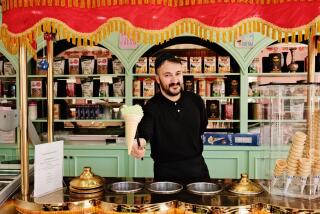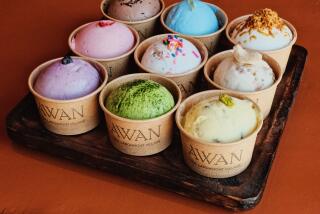The ice cream truck vs. the Instagram influencers
- Share via
This was taken from the Essential California newsletter, written by Julia Wick.
Instagram has fundamentally changed the way the culinary industry operates in Los Angeles and beyond in recent years, but Joe Nicchi had kept it simple when he opened his food truck in 2014.
Nicchi, who looks a little bit like actor Vincent Gallo — if Vincent Gallo were someone who could be cast as the “scruffy” character on a popular network sitcom — sells his ice cream out of a vintage 1960s Mister Softee truck. (Because this is Los Angeles, Nicchi is also an actor. “I know, it’s so cliché. Commercials paid the bills for the first truck.”)
Forget the made-to-be-geotagged unicorn flavors or the otherworldly swirl of a black charcoal soft-serve that commands lines halfway down the block. Nicchi’s soft-serve ice cream business offers three aggressively simple options — chocolate, vanilla or twist, hence the name, CVT Soft Serve.
But the “influencers” kept coming to ask Nicchi for free ice cream.
“At first I was confused,” Nicchi explained over the phone, before launching into a slightly different tone of voice to re-create one of the encounters: “It’s like, ‘Hey, what’s up. So, I don’t know if you follow me but I have 100,000 followers. Could you hook me up with an ice cream? I’ll post about you in my story.’
“It totally threw me. I’m like, this is a $4 item. What are you talking about?” And then it became normal, something that happened at least once a week. There was a constant barrage of influencers coming up to his truck or sending emails, demanding special treatment and devaluing his product — which, for the record, is a family recipe passed down from his father, who has long served soft-serve ice cream for dessert in his upstate New York restaurants.
Instagram influencer marketing is a now-ubiquitous, billion-dollar industry, but in many ways it’s also still the Wild West. The Federal Trade Commission only started enforcing its guidelines in 2017, and the broader market and its mores remain a rapidly evolving playing field.
Instagram influencers tend to be digital natives who wield a kind of credibility with their audiences that might be difficult to buy through the avenues of traditional advertising. “The good influencers can really make you feel like you’re a part of everything,” said Evan Asano, founder and CEO of Mediakix, a leading influencer marketing agency.
And if the life that they’re presenting is one that you too would like to lead, well, that influencer is arguably the world’s foremost expert on just how to get there — and what to do, wear, buy and eat along the way.
The business of food influencers “has grown like crazy,” as Asano explained, and some restaurants take social media into account as they design their physical space. Restaurants can “trend on Instagram,” which not only generates buzz but can also translate into increased foot traffic and IRL dollars cycling through the cash register.
Restaurants giving free food to influencers “used to be common,” according to Asano. But that’s changed in the last two years, as “the influencer fads started to saturate.” Suddenly, everyone was an “influencer” and they all wanted free stuff.
“Recently, there’s been a huge backlash about it,” Asano said, explaining that many restaurants have made it a policy to no longer participate. “If you just have 10,000 followers and you want a free steak, it’s just not going to happen anymore.
“Restaurants and hotels now are getting flooded. Some get 30 [requests] a day,” Asano said.
Every human has a breaking point. When Joe Nicchi reached his, the small-business owner found himself at a copy shop in West Hollywood on Sunday morning, printing and laminating a sign that read “Influencers Pay Double” to place in his truck window before he got to the Melrose Trading Post.
And then, like many a denizen of the 21st century before him, he proudly posed for a picture with his handiwork and uploaded it to Instagram. Needless to say, it went viral.
More to Read
Eat your way across L.A.
Get our weekly Tasting Notes newsletter for reviews, news and more.
You may occasionally receive promotional content from the Los Angeles Times.











